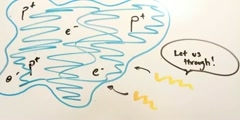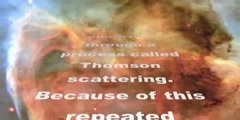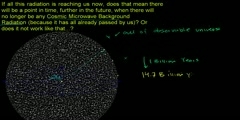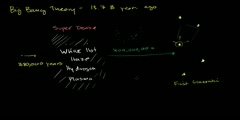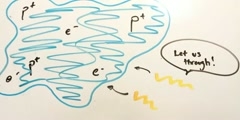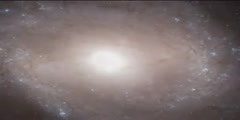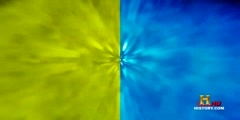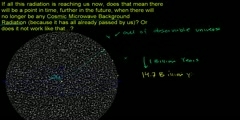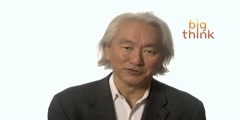Lec 18- Hubble's Law and the Big Bang (cont.)
"Lec 18- Hubble's Law and the Big Bang (cont.)" Frontiers/Controversies in Astrophysics (ASTR 160) Professor Bailyn returns to the subject of the expansion of the universe to offer explanations that do not require belief in the Big Bang theory. One alternative is a theory that, in the past, the entire universe was reduced to an "initial singularity," in which everything was much closer, and therefore denser and hotter. Since the universe is in constant flux, however, it follows that in the future things will drift apart. The Steady State explanation for the expansion of the universe is then explained. Coined as a derogatory term meant to ridicule supporters of the Big Bang theory, Steady State purports that new energy and matter are constantly created as the universe expands, to fill in the void that results from the expansion. The discovery of quasars refuted the Steady State theory. The lecture ends with a discussion of how observing very distant objects allows us to look back in time, and also gives us a glimpse into the future of galaxies and the universe. 00:00 - Chapter 1. The Expanding Universe -- Big Bang and Steady State Theories 09:53 - Chapter 2. Quasars and the Rejection of the Steady State Theory 32:21 - Chapter 3. Calculating the Duration of the Big Bang 43:16 - Chapter 4. Calculating the Potential Future of the Universe Complete course materials are available at the Open Yale Courses website: http://open.yale.edu/courses This course was recorded in Spring 2007.
Video is embedded from external source so embedding is not available.
Video is embedded from external source so download is not available.
Channels: Astrophysics
Tags: Alpha Centauri Big Bang cosmology crunch cosmic microwave background critical density first three minutes Hubble diagram Hubbles Law lookback time scale factor steady state string theory the universal expansion
Uploaded by: yalefrontcont ( Send Message ) on 02-09-2012.
Duration: 50m 13s
Here is the next lecture for this course
Lec 17 - Hubble's Law and the Big Bang (c ...
51:51 | 3595 viewsLec 16 - Hubble's Law and the Big Bang
50:49 | 4322 viewsLec 23 - Other Constraints: The Cosmic Mi ...
47:08 | 3600 viewsCosmic Microwave Background Radiation
02:02 | 6340 viewsBig bang theory
05:58 | 19147 viewsCosmic Microwave Background Radiation Exp ...
07:16 | 7091 viewsDiscovery of Cosmic Microwave Background ...
12:15 | 5579 viewsHow To Detect Remnants Of Big Bang?
02:02 | 3361 viewsChapter 8 Hubble Space Telescope
06:07 | 5443 viewsThe Dark Matter Mystery: Most Of The Univ ...
00:00 | 10753 viewsThe cosmic microwave background radiation ...
02:13 | 5781 viewsThe cosmic microwave background radiation
02:13 | 5346 viewsUnderstanding Cosmic Microwave Background ...
07:16 | 6817 viewsBang Goes The Theory
03:22 | 3398 viewsMichio Kaku on The Multiverse and String ...
02:25 | 7526 viewsNo content is added to this lecture.
This video is a part of a lecture series from of Yale
Lecture list for this course
Lec 1- Introduction to Frontiers Controversies in Astrophysics
Lec 3 - Our Solar System and the Pluto Problem
Lec 4 - Discovering Exoplanets: Hot Jupiters
Lec 6 - Microlensing, Astrometry and Other Methods
Lec 7 - Direct Imaging of Exoplanets
Lec 8 - Introduction to Black Holes
Lec 9 - Special and General Relativity
Lec 11 - Special and General Relativity (cont.)
Lec 12 - Stellar Mass Black Holes
Lec 13 - Stellar Mass Black Holes (cont.)
Lec 15 - Supermassive Black Holes
Lec 16 - Hubble's Law and the Big Bang
Lec 17 - Hubble's Law and the Big Bang (cont.)
Lec 19 - Omega and the End of the Universe
Lec 21 - Dark Energy and the Accelerating Universe and the Big Rip




